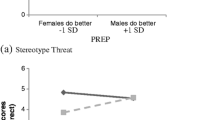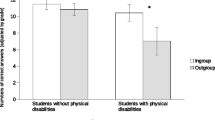Abstract
The negative effects of stereotype threat on one’s behavior and performance have been proved in stereotype research that adopted experimental manipulation. Focusing on the academic performance of student athletes, this research mainly examined the stereotype effects triggered by positive and negative impressions on high school athletes’ mathematics performance, and the mediating role of self-handicapping between stereotypes and one’s performance. A total of 197 high school student athletes (M = 16.55 years, SD = 0.56) who consistently joined competitive athletics training and competitions above the interschool level were collected, positive and negative conditions were simulated by the reading of short texts, and instructions were given to categorize mathematics tests as difficult or easy (the tests’ content being in fact identical). Four conditions were distinguished, namely positive-easy (PE), negative-easy (NE), positive-difficult (PD), and negative-difficult (ND) conditions. A mathematics test comprising 12 questions was used as academic performance indicator. The accuracy of the answers and the participants’ attempts to answer were calculated. The research results indicate that, in terms of accuracy, the interaction between stereotypes and difficulty level was nonsignificant, but the mathematical accuracy of the students who received positive conditions was significantly better than that of those who received negative conditions. In terms of the number of questions answered, the interaction between stereotypes and difficulty level was significant. The participants in the ND condition performed the worst in terms of the number of questions answered. In addition, the latter partially mediated between stereotype and mathematical accuracy. The research results confirm that student athletes are indeed affected by stereotype threat and might resort to behavioral self-handicapping by making less effort, which further affects their performance.


Similar content being viewed by others
References
Aronson, J., & Steele, C. M. (2005). Stereotypes and the fragility of academic competence, motivation, and self-concept. In A. J. Elliot & C. S. Dweck (Eds.), Handbook of Competence and Motivation (pp. 436–456). Guilford Publications.
Baron, R. M., & Kenny, D. A. (1986). The moderator-mediator variable distinction in social psychological research: Conceptual, strategic, and statistical considerations. Journal of Personality & Social Psychology, 51(6), 1173–1182. https://doi.org/10.1037//0022-3514.51.6.1173.
Cadinu, M., Maass, A., Frigerio, S., Impagliazzo, L., & Latinotti, S. (2003). Stereotype threat: The effect of expectancy on performance. European Journal of Social Psychology, 33(2), 267–285. https://doi.org/10.1002/ejsp.145.
Carlson, R. V., Boyd, K. M., & Webb, D. J. (2004). The revision of the declaration of Helsinki: Past, present and future. British Journal of Clinical Pharmacology, 57(6), 695–713. https://doi.org/10.1111/j.1365-2125.2004.02103.x.
Chalabaev, A., Major, B., Sarrazin, P., & Cury, F. (2012). When avoiding failure improves performance: Stereotype threat and the impact of performance goals. Motivation and Emotion, 36(2), 130–142. https://doi.org/10.1007/s11031-011-9241-x.
Cheryan, S., & Bodenhausen, G. V. (2000). When positive stereotypes threaten intellectual performance. Psychology Science, 11(5), 399–402. https://doi.org/10.1111/1467-9280.00277.
Cohen, J. (1992). A power primer. Psychological Bulletin, 112(1), 155–159. https://doi.org/10.1037/0033-2909.112.1.155.
Cundiff, J. L., Vescio, T. K., Loken, E., & Lo, L. (2013). Do gender-science stereotypes predict science identification and science career aspirations among undergraduate science majors? Social Psychology of Education, 16(4), 541–554. https://doi.org/10.1007/s11218-013-9232-8.
Davies, P. G., Spencer, S. J., & Steele, C. M. (2005). Clearing the air: Identity safety moderates the effects of stereotype threat on women's leadership aspirations. Journal of Personality and Social Psychology, 88(2), 276–287. https://doi.org/10.1037/0022-3514.88.2.276.
Deemer, E. D., Thoman, D. B., Chase, J. P., & Smith, J. L. (2014). Feeling the threat: Stereotype threat as a contextual barrier to women’s science career choice intentions. Journal of Career Development, 41(2), 141–158. https://doi.org/10.1177/0894845313483003.
Devine, P. G., & Baker, S. M. (1991). Measurement of racial stereotype subtyping. Personality and Social Psychology Bulletin, 17(1), 44–50. https://doi.org/10.1177/0146167291171007.
Edwards, H. (1984). The black “dumb jock”: An American sports tragedy. College Board Review, 131, 8–13.
Engstrom, C. M., & Sedlacek, W. E. (1991). A study of prejudice toward university student-athletes. Journal of Counseling & Development, 70(1), 189–193. https://doi.org/10.1002/j.1556-6676.1991.tb01582.x.
Frantz, C. M., Cuddy, A. J. C., Burnett, M., Ray, H., & Hart, A. (2004). A threat in the computer: The race implicit association test as a stereotype threat experience. Personality and Social Psychology Bulletin, 30(12), 1611–1624. https://doi.org/10.1177/0146167204266650.
Gonzales, P. M., Blanton, H., & Williams, K. J. (2002). The effects of stereotype threat and double-minority status on the test performance of women. Personality and Social Psychology Bulletin, 28(5), 659–670. https://doi.org/10.1177/0146167202288010.
Griffin, W. (2017). Who is whistling Vivaldi? How black football players engage with stereotype threats in college. International Journal of Qualitative Studies in Education, 30(4), 354–369. https://doi.org/10.1080/09518398.2016.1250174.
Harrison, C. K. (2002). Scholar or baller in American higher education? A visual elicitation and qualitative assessment of the revenue college athlete mindset. National Association of Student Affairs Professionals Journal, 8(1), 66–81.
Harrison, C. K., Stone, J., Shapiro, J., Yee, S., Boyd, J., & Rullan, V. (2009). The role of gender identities and stereotype salience with the academic performance of male and female college athletes. Journal of Sport & Social Issues, 33(1), 78–96. https://doi.org/10.1177/0193723508328902.
Hively, K., & El-Alayli, A. (2014). “You throw like a girl:” the effect of stereotype threat on women's athletic performance and gender stereotypes. Psychology of Sport and Exercise, 15(1), 48–55. https://doi.org/10.1016/j.psychsport.2013.09.001.
Jameson, M., Diehl, R., & Danso, H. (2007). Stereotype threat impacts college athletes’ academic performance. Current Research in Social Psychology, 12(5), 68–79. https://doi.org/10.4135/9781412956253.n558.
Jones, E. E., & Berglas, S. (1978). Control of attributions about the self through self-handicapping strategies: The appeal of alcohol and the role of underachievement. Personality and Social Psychology Bulletin, 4(2), 200–206. https://doi.org/10.1177/014616727800400205.
Keller, J. (2002). Blatant stereotype threat and women’s math performance: Self-handicapping as a strategic means to cope with obtrusive negative performance expectations. Sex Roles, 47(3–4), 193–198. https://doi.org/10.1023/A:1021003307511.
Li, Y. R., & Hsu, Y. W. (2018). Literature review of the effects of stereotype threat on student-athletes’ academic performance. Quarterly of Chinese Physical Education, 32(2), 151–158. https://doi.org/10.3966/102473002018063202007.
Moskowitz, G. B., & Carter, D. (2018). Confirmation bias and the stereotype of the black athlete. Psychology of Sport and Exercise, 36, 139–146. https://doi.org/10.1016/j.psychsport.2018.02.010.
Riciputi, S., & Erdal, K. (2017). The effect of stereotype threat on student-athlete math performance. Psychology of Sport and Exercise, 32, 54–57. https://doi.org/10.1016/j.psychsport.2017.06.003.
Schmader, T. (2010). Stereotype threat deconstructed. Current Directions in Psychological Science, 19(1), 14–18. https://doi.org/10.1177/0963721409359292.
Shapiro, J. R., & Neuberg, S. L. (2007). From stereotype threat to stereotype threats: Implications of multi-threat framework for causes, moderators, mediators, consequences, and interventions. Personality and Social Psychology Review, 11(2), 107–130. https://doi.org/10.1177/1088868306294790.
Shapiro, J. R., Williams, A. M., & Hambarchyan, M. (2013). Are all interventions created equal? A multi-threat approach to tailoring stereotype threat interventions. Journal of Personality and Social Psychology, 104(2), 277–288. https://doi.org/10.1037/a0030461.
Shih, M., Pittinsky, T. L., & Ambady, N. (1999). Stereotype susceptibility: Identity salience and shifts in quantitative performance. Psychological Science, 10(1), 80–83. https://doi.org/10.1111/1467-9280.00111.
Sinclair, S., & Carlsson, R. (2013). What will I be when I grow up? The impact of gender identity threat on adolescents' occupational preferences. Journal of Adolescence, 36(3), 465–474. https://doi.org/10.1016/j.adolescence.2013.02.001.
Spencer, S. J., Steele, C. M., & Quinn, D. M. (1999). Stereotype threat and women’s math performance. Journal of Experimental Social Psychology, 35(1), 4–28. https://doi.org/10.1006/jesp.1998.1373.
Steele, C. M. (1997). A threat in the air: How stereotypes shape intellectual identity and performance. American Psychologist, 52(6), 613–629. https://doi.org/10.1037/0003-066X.52.6.613.
Steele, C. M., & Aronson, J. (1995). Stereotype threat and the intellectual test performance of African Americans. Journal of Personality and Social Psychology, 69(5), 797–811. https://doi.org/10.1037//0022-3514.69.5.797.
Steele, C. M., Spencer, S. J., & Aronson, J. (2002). Contending with group image: The psychology of stereotype a social identity threat. In M. P. Zanna (Ed.), Advances in experimental social psychology (Vol. 34, pp. 379–440). Boston: Academic Press. https://doi.org/10.1016/S0065-2601(02)80009-0.
Stone, J. (2002). Battling doubt by avoiding practice: The effects of stereotype threat on self-handicapping in White athletes. Personality and Social Psychology Bulleting, 28(12), 1667–1678. https://doi.org/10.1177/014616702237648.
Stone, J., Harrison, C. K., & Mottley, J. (2012). “Don't call me a student-athlete”: The effect of identity priming on stereotype threat for academically engaged African American college athletes. Basic and Applied Social Psychology, 34(2), 99–106. https://doi.org/10.1080/01973533.2012.655624.
Stone, J., Lynch, C. I., Sjomeling, M., & Darley, J. M. (1999). Stereotype threat effects on black and White athletic performance. Journal of Personality and Social Psychology, 77(6), 1213–1227. https://doi.org/10.1037/0022-3514.77.6.1213.
Stout, J. G., Dasgupta, N., Hunsinger, M., & McManus, M. A. (2011). STEMing the tide: Using ingroup experts to inoculate women's self-concept in science, technology, engineering, and mathematics (STEM). Journal of Personality and Social Psychology, 100(2), 255–270. https://doi.org/10.1037/a0021385.
Wininger, S. R., & White, T. A. (2015). An examination of the dumb jock stereotype in collegiate student-athletes: A comparison of student versus student-athlete perceptions. Journal for the Study of Sports and Athletes in Education, 9(2), 75–85. https://doi.org/10.1179/1935739715Z.00000000036.
Woodcock, A., Hernandez, P. R., Estrada, M., & Schultz, P. (2012). The consequences of chronic stereotype threat: Domain dis-identification and abandonment. Journal of Personality and Social Psychology, 103(4), 635–646. https://doi.org/10.1037/a0029120.
Yopyk, D. J., & Prentice, D. A. (2005). Am I an athlete or a student? Identity salience and stereotype threat in student-athletes. Basic and Applied Social Psychology, 27(4), 329–336. https://doi.org/10.1207/s15324834basp2704_5.
Acknowledgements
This study was supported by the Ministry of Science and Technology, Taiwan (MOST 107-2410-H-415-034).
Author information
Authors and Affiliations
Corresponding author
Ethics declarations
Conflict of Interest
The authors declare that they have no conflict of interest.
Additional information
Publisher’s Note
Springer Nature remains neutral with regard to jurisdictional claims in published maps and institutional affiliations.
Rights and permissions
About this article
Cite this article
Hsu, Y., Li, Y. Influences of stereotype threat on the mathematics performance of high school athletes. Curr Psychol 41, 3452–3460 (2022). https://doi.org/10.1007/s12144-020-00870-6
Published:
Issue Date:
DOI: https://doi.org/10.1007/s12144-020-00870-6




